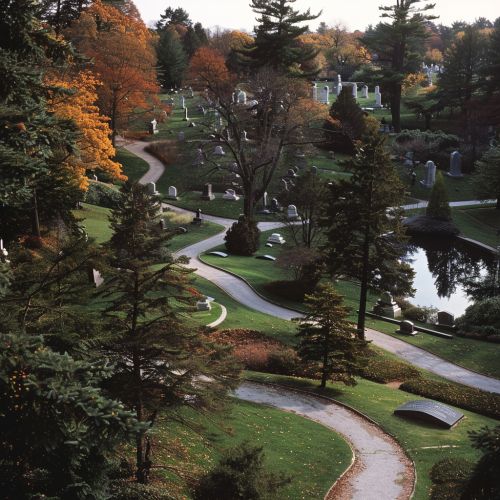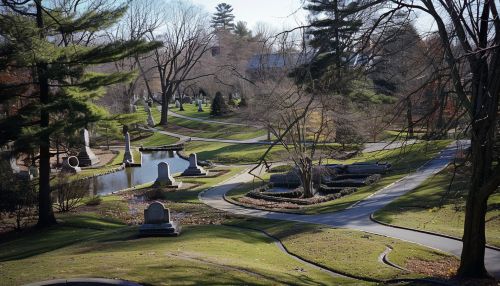Mount Auburn Cemetery
History
Mount Auburn Cemetery, located in Cambridge and Watertown, Massachusetts, is one of the most historically significant cemeteries in the United States. Established in 1831 by the Massachusetts Horticultural Society, it is recognized as the first rural, or garden, cemetery in the country. This innovative design marked a departure from the crowded, urban churchyards and burial grounds that were common at the time. The cemetery was conceived as a place not only for burial but also for public enjoyment, with an emphasis on natural beauty and landscape design.
The founders of Mount Auburn Cemetery, including Dr. Jacob Bigelow, Henry A. S. Dearborn, and Alexander Wadsworth, were influenced by the European garden cemetery movement, particularly Père Lachaise Cemetery in Paris. They envisioned a cemetery that would serve as a tranquil retreat from the bustling city, where people could find solace and inspiration in nature. The cemetery's design incorporated winding paths, picturesque vistas, and a diverse collection of trees and plants, creating a serene and contemplative environment.
Landscape and Design
Mount Auburn Cemetery spans 174 acres and features a meticulously planned landscape that combines naturalistic and formal elements. The cemetery's layout was designed by Henry A. S. Dearborn and Alexander Wadsworth, who drew inspiration from the English landscape garden tradition. The design includes curving roads and paths, strategically placed ponds, and carefully selected plantings to create a harmonious and aesthetically pleasing environment.
The cemetery is home to a diverse array of trees, shrubs, and flowering plants, many of which were chosen for their symbolic meanings and seasonal beauty. Notable specimens include the weeping beech, the dawn redwood, and the Franklin tree. The landscape also features several ponds, including Halcyon Lake and Auburn Lake, which provide habitat for various bird species and contribute to the overall tranquility of the setting.


Monuments and Memorials
Mount Auburn Cemetery is renowned for its impressive collection of monuments and memorials, which reflect a wide range of artistic styles and historical periods. The cemetery's monuments include obelisks, statues, mausoleums, and intricate gravestones, many of which were designed by prominent artists and architects of the 19th and 20th centuries.
One of the most notable monuments in the cemetery is the Sphinx, a granite sculpture created by Martin Milmore in 1872. The Sphinx commemorates the preservation of the Union during the American Civil War and stands as a symbol of strength and endurance. Another significant monument is the Bigelow Chapel, a Gothic Revival structure designed by Dr. Jacob Bigelow and constructed in 1846. The chapel serves as a focal point for the cemetery and is used for various ceremonies and events.
The cemetery also features the Washington Tower, a 62-foot granite tower built in 1854. Visitors can climb to the top of the tower for panoramic views of the surrounding landscape and the Boston skyline. The tower is named in honor of George Washington and serves as a reminder of the cemetery's historical significance.
Notable Interments
Mount Auburn Cemetery is the final resting place of many notable individuals from various fields, including politics, literature, science, and the arts. Some of the most prominent figures buried at Mount Auburn include:
- Henry Wadsworth Longfellow, the celebrated American poet known for works such as "Paul Revere's Ride" and "The Song of Hiawatha."
- Mary Baker Eddy, the founder of the Christian Science movement and author of "Science and Health with Key to the Scriptures."
- Oliver Wendell Holmes Sr., a physician, poet, and polymath who was a prominent figure in 19th-century American literature and medicine.
- Charles Sumner, a leading abolitionist and U.S. Senator who played a key role in the fight against slavery.
- Winslow Homer, a renowned American painter and printmaker known for his landscapes and seascapes.
Horticulture and Wildlife
Mount Auburn Cemetery is not only a burial ground but also a significant horticultural and ecological site. The cemetery's diverse plantings and carefully maintained landscape provide habitat for a wide variety of wildlife, including birds, mammals, and insects. The cemetery is particularly known for its birdwatching opportunities, as it serves as a stopover for migratory birds along the Atlantic Flyway.
The cemetery's horticultural collections include a wide range of trees, shrubs, and perennials, many of which are labeled with their scientific names for educational purposes. The cemetery's horticultural staff is dedicated to preserving and enhancing the landscape, with a focus on sustainable practices and the conservation of rare and endangered plant species.
Conservation and Preservation
Mount Auburn Cemetery has a long-standing commitment to conservation and preservation. The cemetery's management works to maintain the historic landscape and monuments while also adapting to contemporary needs and environmental challenges. This includes efforts to preserve the cemetery's historic structures, such as the Bigelow Chapel and the Washington Tower, as well as the ongoing care and restoration of monuments and gravestones.
The cemetery also engages in various conservation initiatives, such as habitat restoration, invasive species management, and the promotion of native plantings. These efforts help to protect the cemetery's ecological integrity and ensure that it remains a sanctuary for both people and wildlife.
Cultural and Educational Programs
Mount Auburn Cemetery offers a variety of cultural and educational programs designed to engage the public and promote an understanding of the cemetery's historical, horticultural, and ecological significance. These programs include guided tours, lectures, workshops, and special events that highlight different aspects of the cemetery's history and landscape.
The cemetery's educational initiatives also extend to partnerships with local schools and universities, providing opportunities for students to learn about topics such as landscape architecture, horticulture, and conservation. The cemetery's archives and collections are valuable resources for researchers and scholars studying a wide range of subjects.
See Also
- Père Lachaise Cemetery
- Rural Cemetery Movement
- Landscape Architecture
- American Civil War Monuments
- Birdwatching
